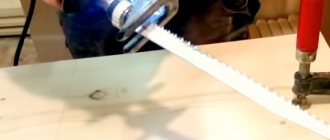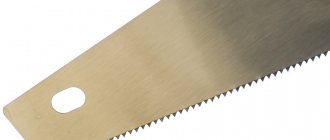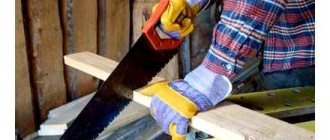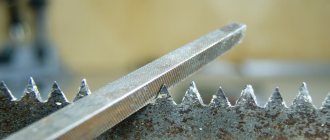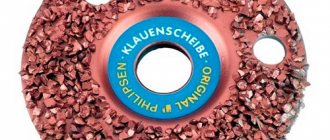A convenient and functional wood hacksaw should always be in the arsenal of a home craftsman. This tool is indispensable for owners of private houses and country cottages.
The right choice affects the performance, cut quality and longevity of the hand saw. The rating of high quality wood hacksaws is presented below.
Canvas size
Depending on your task, you can choose different blade lengths. For simple boards and small bars, a length from twenty-eight to thirty centimeters is quite suitable. If construction work is underway, then it would be wiser to take a canvas from forty-five to fifty centimeters long.
The basic rule: the length of the product should be half the length of the hacksaw itself, otherwise you can forget about ease of use.
Conclusion
Based on the recommendations given above and the video in this article, choosing the right hacksaw for wood will become much easier for you and keep in mind that wasted money is not the worst thing, a poor-quality tool will take a lot of time and effort, and most importantly, such hacksaws can be dangerous. If you want to add something to what has been said or have any questions, welcome to the comments, let’s chat.
Every true craftsman (even at home) always has a convenient and multifunctional circular electric saw. But sometimes there are types of work when you only need to saw off one part, or just do small amounts of work, but you don’t want to get out an electrical device. In this case, a hacksaw blade will help you out. But we’ll look further at how to choose a good hacksaw for wood that will be easy to use and can easily “gnaw through” any type of wood.
The saw can rightfully be called the mother of all hand tools. From the moment people realized the importance of iron and created the first saw, the tool has changed many times and already has a dozen “sisters” that can be used to perform any type of work.
Let's take a closer look at what each of these parameters should be.
Hacksaw blade - what it should be like
The main part of the tool is the blade. The first thing you should pay attention to when choosing a hacksaw for wood is the length of the blade. A lot will depend on this, at least even the possibilities of application.
At the same time, the larger the canvas, the more it will spring, which will complicate the process, especially when working with maple, ash and oak.
If you plan to saw bars or narrow slats, a tool with a length of 25 to 30 cm will be enough for you. When planning to use a tool for serious work in construction, give preference to tools with a blade length of 50 cm.
When choosing the length, you should be guided by the rule that the length should exceed the diameter of the element being processed by exactly 2 times.
If you don't follow this recommendation, you will make your job more difficult. The teeth of a short hacksaw will only jam in the wood, and it will be very difficult to move such a saw to free it from sawdust.
Working in an uncomfortable environment will cause you to become tired sooner than if you had followed all the instructions.
Typically, the width of a hacksaw blade is from 10 to 20 cm. Models with a smaller width have many disadvantages, since they are impractical and will immediately fail. But keep in mind that tools that are too wide will not give you comfort.
For the manufacture of hacksaws, alloy steel is used, which differs from ordinary steel in its high content of carbon and silicon of the following grades:
- 65G, 60 S2A.
- 8 XF, 9 XF, 9 XC.
- Y7, Y7A, Y8, Y8A, Y8G, Y8GA, Y9A, Y10.
The metal is hardened by special exposure to a magnetic field, due to which a high-frequency electric current appears.
When it spreads on the surface, it heats up the top layer of metal, after which it is quenched with cold water. According to the standard, the hardness of the metal should be 45 HRC, but it is better to give preference to products whose blade hardness will be from 55 to 60.
A high-density wood saw will have good flexibility, but the teeth will be stable. Externally, upon inspection, you will determine the quality of the instrument by the dark shade of the sharpened teeth.
Sharpening and tooth size
The size and sharpness of the teeth is one of the main criteria when choosing a hacksaw. The bottom line is that the small teeth on a hacksaw are for fine work and the long teeth are for rougher work, they are well suited for gardening where neatness is not an issue.
By looking at the photo of wood hacksaws with various teeth, you will see which hacksaw is right for you.
In the hacksaw market, there is a TPI unit, on which the cutting accuracy directly depends; it determines the number of teeth per 1 inch. For example, you need to cut a couple of chipboard boards, in this case it is recommended to use hacksaws with a TPI in the range of seven to nine, then the cut will be smooth and neat.
If you need to work in the garden, cutting down branches, for example, then accuracy is not so important; a hacksaw with a TPI of three to six will suffice. The tooth pitch can be from two and a half to six and a half millimeters and from one and a half to five millimeters.
The shape of the teeth of a classic saw is triangular and can be easily sharpened. However, in modern realities you can more often find hacksaws with trapezoidal teeth. It positions itself as a stronger and more durable saw.
But proper sharpening with such a tool will be impossible, because the steel from which the hacksaw is made does not lend itself to a simple file, and it will be almost impossible to repeat this shape. As soon as the saw becomes dull, we either change the blade or go and buy a new one.
Sharpening a hacksaw on wood with your own hands is not a difficult task, but it is not easy either. Before starting sharpening, it is necessary to carry out routing so that the blade does not jam during sharpening. To do this, we use a special tool called sharpening.
Sharpening itself requires completely different tools.
Model rating
Many home craftsmen are interested in which hacksaw is best for wood? When choosing such a tool, you should carefully consider several parameters.
This is a high-quality material, an ergonomic handle, correct sharpening of the teeth and the optimal length of the blade for cutting. All of the following criteria are met:
- Archimedes 90664 350 mm;
- Vira 800245 450 mm;
- Armero A531/400 400 mm;
- Gross Piranha 24111 400 mm ;
- BAHCO Superior 2600-16-XT11-HP 400 mm.
All of the listed models have their own advantages and disadvantages. They are described in more detail below.
Archimedes 90664 350 mm – coating for protection against mechanical damage on the saw blade
This tool is the best in the price-quality category. The blade of this hacksaw is made of carbon steel. To protect against damage, the hand saw blade is coated with a special varnish. The triangular sharpening of the large teeth of the tool allows you to make quick and easy cuts.
These cutting elements can be sharpened repeatedly. The two-piece one-piece handle provides reliable control and a comfortable grip. The handle is made of thermoplastic elastomer and durable polypropylene.
Thanks to the special design of the teeth, the saw can be used for longitudinal cuts. Durable and wear-resistant blade Archimedes 90664 leaves behind an even cut with a small amount of sawdust. To make the tool convenient to store, the manufacturer made a hole on it for hanging.
Pros:
- comfortable handle;
- teeth can be re-sharpened;
- price.
Minuses:
- The hacksaw blade may bend.
Vira 800245 450 mm – scale with divisions on the blade
This hand saw is made of hardened steel. This material provides it with high strength. The tool will quickly cut even raw hardwood.
The manufacturer has equipped the hacksaw with a comfortable handle to securely hold the tool while working. Suitable for cutting both across and along the grain.
The Vira 800245 canvas has a special scale marking that will replace the ruler if it is not at hand. The optimal length will allow you to cut more wood in a short time. The tool is equipped with 7 teeth, which allow you to get a cleaner cut when sawing.
Pros:
- sharp sharpening;
- there is a marking scale;
- price.
Minuses:
- uncomfortable case.
Armero A531/400 400 mm – light weight and comfortable handle
This wood hacksaw for the home workshop has a two-piece handle with a protective aluminum insert. The saw is practically not felt in the hand due to its light weight. At the same time, she quickly makes a cut and leaves behind an even cut.
The tool is made of tool steel and has medium-sized hardened teeth. 3D sharpening makes the blade very sharp and is suitable even for hard wood.
Three cutting edges of Armero A531/400 ensure fast cutting and the absence of a large amount of sawdust during operation. The anti-slip coating of the ergonomic handle will prevent accidental slipping during intensive sawing.
The tool is designed for cross cutting. This hacksaw is easy to store. For this purpose, a hole for hanging is made on its upper part.
Pros:
- fits comfortably in the hand;
- medium clove;
- light.
Minuses:
- There is no rubberized insert for the hand on the handle.
Gross Piranha 24111 400 mm – fine cut without debris
This tool rightfully takes a place in our ranking of hacksaws for 2022. It is suitable for cross-cutting and longitudinal cutting of wood blanks. The two-piece hacksaw handle helps provide maximum saw control and a comfortable grip while working.
A special hole for hanging will make it more convenient to store the hacksaw. The Teflon coating makes this saw resistant to mechanical damage and significantly extends its service life.
The hardened teeth of the Gross Piranha 24111 help you quickly cut through any type of wood. This hacksaw is suitable not only for working on wood, but also for processing laminate with polystyrene foam. This hand tool can also be used for cutting parts made of polyurethane, chipboard, MDF, fiberboard. The model comes with a cover for the cutting edge.
Pros:
- thin cut;
- cuts quickly;
- comfortable handle;
- the hand does not get tired;
- produces few chips;
- There is a cover for the cutting edge.
Minuses:
- price.
Instructions for properly sharpening a hacksaw
Before starting work, you need to firmly clamp your blade in a vice so that it does not wobble. Having secured the blade, take a file and begin sharpening the left edge on the first tooth. When doing this, you need to hold the file at a sixty-degree angle.
Use a file using even and smooth movements. In exactly the same way, you should sharpen all the left parts of the odd teeth, and then the right ones. Then we turn the blade over, fasten and sharpen the teeth of the even row.
Having finished the work, be sure to clean the blade from burrs with a specialized velvet file.
How to choose a piston compressorIn what cases is washing machine repair needed, what should everyone know?
Do-it-yourself wood splitter - drawings, diagrams, dimensions. 120 photos of homemade wood splitters
Trusted manufacturers of hand saws for wood
- "Bison"
- a domestic manufacturer with a good reputation. Almost all hacksaws from Zubr come with a hardened set tooth and high-quality sharpening. The company specializes in products with medium and fine teeth, but the line also includes other models, including those with replaceable blades;Models of hacksaws with replaceable blades are classified as semi-professional tools
- "Gross Piranha"
- here we are dealing with combination hacksaws. The main blade in such a tool is made of flexible steel HRc52, and the cutting edge with teeth is made of high-strength hardened iron HRc66. The special pride of this brand is the line of “Piranha” models, which additionally has a Teflon coating and laser sharpening of the tooth;Piranha hacksaws with Teflon coating and laser sharpening are particularly durable and easy to move
- "Stanley General Purpose"
— initially this brand belonged to representatives of the French industry, but now they have opened several subsidiaries in Russia, which has allowed them to reduce the price without losing the quality of the product. The basic set is also present here, that is, a hardened tooth and laser sharpening. The most popular model is with TPI8 pitch;French hacksaws have been famous for their high quality for more than half a century
- Irwin Xpert
— models of this brand are of high quality, but compared to the saws mentioned above, they are almost 2 times more expensive. Although, according to the owners, this tool is worth the money;The special configuration of the cutting edge in hacksaws from Irwin Xpert allows you to work equally successfully with both raw and hard dry wood
- "Sandvik"
— the quality of Swedish instruments has been famous for several hundred years. Sandvik is the old name of the well-known Bahco brand. In our market, the Swedes have created a joint venture and produce high-quality hacksaws under the name “Tyosha”. There is no priority for certain models; all tools from this brand are of high quality.Swedish hacksaws produced under the domestic brand “Tyosha” are famous for their excellent quality
The right approach to choosing a hacksaw
Works in which hacksaws are used are divided into carpentry and joinery. In carpentry, accuracy is more important, while in carpentry, speed is more important.
First of all, you should pay attention to the quality of the metal of the blade; to do this, we take the hacksaw in our hands and bend it 30-45 degrees. This must be done as carefully as possible, since low-quality metal is very easy to break.
After carrying out this operation, let's look at the bend; if a slight deviation appears there, then the metal of this product is of very low quality.
The most important criterion when choosing your hacksaw is the price. Naturally, the choice before you is a cheap Chinese hacksaw of poor quality or an expensive saw from a well-known brand. However, having overpaid once, you will no longer have to constantly change the blade or buy a new tool. Major brands pay close attention to the quality of steel and hardening used in their blades.
Septic tank Topas - detailed review and description of technical characteristicsPetrol mower repair: overview of faults and effective methods for solving them. Photo instructions from the pros!
- Garden composter - which one to choose? Review of the best views for a summer residence (100 photos)
The main tasks of the teeth are to remove sawdust and, directly, to cut the wood itself.
Teeth with a TPI setting of up to seven are fast and easy to use. Therefore, the choice of a hacksaw should depend entirely on your own needs.
How to choose a hand saw
By combining all the basic parameters of the saw, everyone can easily decide for themselves which one suits them best. When choosing a tool, you need to decide for yourself which saw is more suitable - a carpenter's or a carpenter's saw. If the most important thing is cutting speed, then, of course, you need to purchase a carpenter's tool. A carpenter's hacksaw has fewer teeth per inch, which allows for faster cutting performance and sawdust removal. If cutting accuracy is a priority, then you should use a carpentry shop.
The quality of a hacksaw can be determined in simple ways. First you need to visually verify the evenness of the canvas. Then you need to bend the canvas with a little effort and release it as soon as resistance appears. After the blade plays back and calms down, you should again check the evenness of the blade. If it is slightly deviated from the original position, then the tool is of poor quality and it is not recommended to buy it.
If you need a rip saw, you need to choose a hacksaw with sharp teeth. The teeth of such saws are sharpened only on one side, so the cut will be made only in one direction - away from you.
The teeth of the rip saw blade are sharpened in the shape of an acute triangle
When longitudinal sawing, the cut occurs parallel to the fibers of the material. For rip sawing, circular saws and bow saws are well suited.
Crosscut saws are the most common. Their teeth are made in the shape of an isosceles triangle and sharpened on both sides. This allows you to cut in both directions
.
For cross cutting, the teeth of the blade are made in the shape of an isosceles triangle and sharpened on both sides
When cross-cutting, the material is cut across the grain. For such sawing, classic hacksaws, hacksaws with a backrest, and, for large material thicknesses, two-handed saws are suitable.
The price of the saw is also an equally important factor when choosing. A more expensive hacksaw guarantees reliability and wear resistance. Those saws whose price is significantly lower than average are made from cheaper raw materials and do not guarantee you long-term service.
Narrow hacksaw
A small narrow hand saw, consisting of a straight thin blade and a handle. It mainly serves for various thin. Most often, it has a blade with triangular double-sided teeth.
One of the main disadvantages of this type of hacksaw is the possibility of deflection during your work with a wooden product.
What is it and what is it for?
A hand saw is a saw blade, the working part of which is equipped with a notch of teeth. On one side there is a handle, holding it to make reciprocating movements. At the same time, the teeth come into contact with the material being processed and saw it in a given direction. A hacksaw is primarily designed for working with wood, although there are special varieties for cutting metals, plastics and other materials.
Despite its main purpose, it is not recommended to cut wood derivatives (chipboard, MDF plywood, etc.) with a regular hacksaw. The teeth become dull quickly and require sharpening. To cut these materials, special tools with carbide tips or hardened teeth are used.
The purpose of a hacksaw is to cut (sawing) materials. It cannot perform any additional functions, but it copes with basic tasks perfectly. The cutting process is the same for all materials, although the quality of the blade is different in each case. The tool is convenient for performing work in the field, has a compact size and light weight, which allows you to take it with you on hikes or trips.
Bow saws
This is a heavy-duty hacksaw. The main advantage of working with this type is the ability to work with the product you need from absolutely any angle. Using a bow saw, you can process the material from any side, lengthwise and crosswise, and make complex workpieces alone.
A small hacksaw is perfect for small jobs in the garden; it is not recommended to use it when sawing large materials.
What types of hand saws are used for what purposes?
- The classic hacksaw is the most common of all. It has a long and wide canvas. If the blade is too long, the hacksaw may tilt to the side when cutting. Great care must be taken to avoid deviation of the cutting line from the initial marking. This hacksaw is suitable for working with timber, boards, chipboard and so on.
- Hacksaw with back. This saw model has a rigid rib attachment, which minimizes the vibration frequency of the blade. This hacksaw also has smaller teeth and a higher TPI coefficient. They are designed for cutting plywood, chipboard with a coating layer and sawing profile strips.
- Finish saws have an adjustable handle. They are needed for cutting grooves, grooves and straight and profile planks.
- A circular hacksaw, or a hacksaw with a narrow blade. It is also used for cutting grooves, as well as for cutting out parts with rounded areas and large holes.
- A bow saw is well suited for cutting knots and rough parts of material, as well as for cutting out parts from plywood and wood. This hacksaw is distinguished by a thin blade fixed on both sides in a frame. It is worth noting that you need to work with it extremely carefully due to its increased fragility.
- The award has two handles. The appearance of such a saw is in many ways similar to a plane. It is used for cutting tenons and grooves, deepening holes and slots in materials of any hardness.
- Garden saw with curved blade. Most often, for greater convenience, they are made folding. This saw is well suited for garden work. The saw blade is made of chrome steel. Widely spaced teeth with an inclination in the direction of the handle will allow you to conveniently cut down twigs and branches, placing emphasis on yourself while cutting.
- A two-handed saw has the highest productivity. It has two wooden handles. For greater efficiency, cutting with such a saw requires two people. A two-handed saw is often used for sawing large logs and trees.
- A hand or pocket chain saw is a small piece of chain with two handles on the ends. This saw is convenient for both one and two people to work with. The log or branch is wrapped around a chain and cut is made using the handles. A manual chainsaw, like a folding one, is well suited for gardening.
Photo gallery: types of hand saws
This classic hacksaw can be easily sharpened This hacksaw has hardened teeth and increased wear resistance A hacksaw with a back or butt minimizes vibrations of the blade during work A hacksaw with a narrow blade is well suited for cutting holes and grooves This saw has an adjustable handle, which will allow you to work under the desired angle A bow saw is good for cutting parts out of plywood This type of hacksaw is similar to a plane and is used for cutting tenons and slots A two-handed saw is suitable for cutting large logs Garden saws with a curved blade are good for cutting knots and small branches of trees A hand chain saw is compact and works well Suitable for cutting logs while camping and branches in the garden
Thus, having carefully studied all the nuances regarding hand saws, everyone will be able to choose the most suitable option for themselves. Choosing the right tool will provide you with high-quality and enjoyable work.
Wood, as a building material, has numerous advantages, not the least of which is ease of processing. Various tools for working with wood are produced, but the simplest and most common is the ordinary handsaw. What parameters are used to select a hacksaw for wood, which is better and what to look for when choosing a new tool?
Classification
There are several varieties designed to perform individual tasks. They are divided into groups according to different characteristics.
By type of canvas:
- Narrow . Used for cutting out various shapes with a relatively large radius of curvature of cutting lines.
- Regular . This is the most common type of saw, has a standard blade width and is designed to perform different jobs.
- Obushkovaya . These tools have a wide blade with fine teeth. Capable of performing clean cuts with high precision. Used for precise, critical work using a template or pre-applied markings. A special feature of backed hacksaws is the need to process material that is obviously thinner than the blade - the presence of a backing will prevent it from being passed through the cut.
- Luchkovaya . A narrow sheet with a small tooth is stretched between two support bars. This design combines several capabilities - clean, neat cuts, cutting accuracy and high productivity.
By type of tasks performed:
- Classic . It is used in most situations when it is necessary to saw off a piece of board, saw through timber or solve other issues of a common nature.
- Trimming . Used to adjust elements protruding above the plane. The handle of such a saw is placed in such a way as not to interfere with the blade coming into contact with the material along its entire length. A special case of a scoring saw is the abutment construction. This group also includes tenoning and edging saws.
- Circular . The narrow blade allows you to make figured cuts. You can cut a closed contour by starting work from a pre-drilled hole. The free end of the blade is not secured, which requires caution during operation—it is easy to bend or deform the saw with a careless movement.
- Plywood saw . It has a wide blade that allows you to hold a straight cut without the danger of taking it to the side. The teeth at the beginning of the blade allow you to start cutting from the middle of the plane.
- Award . This saw is capable of performing specific tasks - cutting grooves and other structural elements. It has several handles, and the method of operation is closer to the method of processing with a plane. Requires skills and experience from the master.
- Folding saw . Typically, such a tool has a handle that is detached or rotated, making the overall length of the hacksaw noticeably shorter. Convenient for a hike, trip or other field conditions.
There is a separate group of tools - Japanese saws.
The traditions of carpentry in this country require virtuoso mastery of the instrument, the quality of which has been elevated to the level of art. The technique of working with Japanese saws cannot be repeated with a conventional hacksaw, since the elasticity of the blade and the ability to maintain shape and plane are used.
The names of the tools are little familiar not only to beginners, but also to experienced specialists:
1-Kataba 2-Ryoba 3-Dozuki
- Kataba . A saw with teeth on one side of the blade. It has a universal sharpening that allows you to perform both longitudinal and cross cuts.
- Rioba . The blade of these tools is equipped with teeth on both sides of the blade, and on one edge there is a notch for longitudinal cutting, and on the other - for cross cutting.
- Dozuki . The flexible blade is designed for precise and accurate cutting. in the area of the handle, the teeth become smaller, which is convenient for performing critical work.
- Mawashibiki . A narrow blade with fine teeth, capable of producing fine and clean work.
A common feature of Japanese hacksaws is their relatively small size and specific method of use. Unlike European tools, which are effective when moving away from you, Japanese saws are all designed to move towards you. This is unusual at first, but experienced people testify to the significant advantages of this technique.

